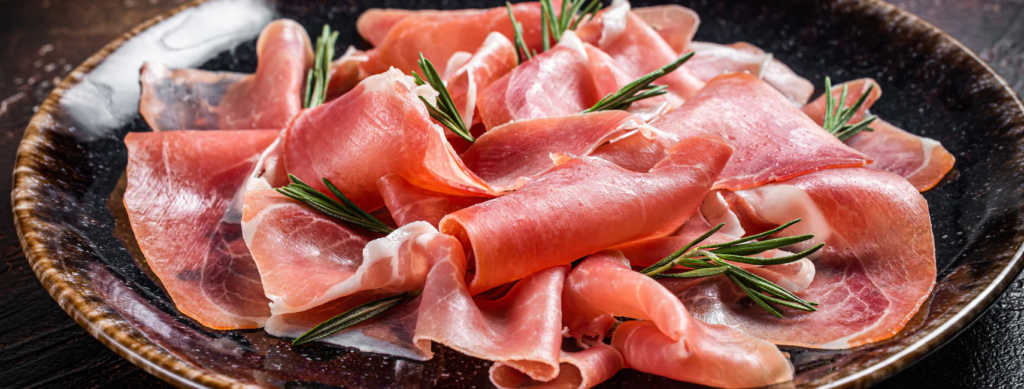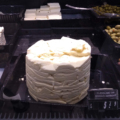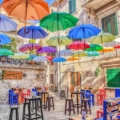
So you want to know more about Montenegrin food. Let me just say it’s very hard to start off the article with only one pic. Montenegrin cuisine ranges so wide, it’s impossible to sum it up in one style. Here, I will make sure to include all the traditional Montenegrin food and some that is a result of fusion.
In the Balkan countries, Montenegro stands out with its unique food experience. Here, every bite of Balkan food demands a sip of local wine. It’s not just tradition—it’s a lifestyle. Dive into Montenegro’s culinary scene, and let the rich flavors of their dishes dance with the fruity notes of their iconic wines. It’s not just a meal; it’s an unforgettable journey!
Dive into the heart of Montenegro, where Mediterranean cuisine takes center stage. Here, every home visit is an invitation to savor soft cheese and bite into warm homemade bread. It’s not just a restaurant specialty—it’s a household staple. Experience Montenegro authentically, where every meal feels like a warm embrace from its people.
Meza – a meal before the meal

Although the closest translation would be ‘appetizer’, which is something you eat before the main meal, Montenegrins don’t use the word ‘appetizer’. We use the word ‘meza’ (MEH – ZAH). It means ‘something you quickly eat’. We view it as a warm-up for the tummy.
The traditional dish of meza isn’t just a Montenegrin starter; it’s an essential part of the entire dining journey. Unlike standard appetizers that vanish before the main course, meza proudly stays on the table, beckoning guests throughout the meal. Drizzled with olive oil and showcasing various types of meats, it’s the perfect accompaniment to cleanse the palate or bridge the gap between courses. So, when you’re at a Montenegrin feast and the meza remains even as the main dish is served, embrace it. It’s this leisurely and communal dining approach that sets Montenegrin cuisine apart.
The classical meza consists of:
Prosciutto

Every Montenegrin household’s fridge has at least 500gr (1.1lbs) of this delicates. If you are ever in Montenegro, just ask for ‘prshuta’ and you will become a favorite guest. What makes it traditional is the fact that Montenegrins rarely buy processed prosciutto, and instead make their own.
In the beautiful country of Montenegro, crafting prshuta, their cherished dry cured ham, is an art steeped in tradition. It demands patience, expertise, and a touch of serendipity. Throughout the seasons, many households meticulously dry and salt their hams, aiming for that impeccable blend of taste and tenderness. While not every home produces its own prshuta, there’s no shortage of local artisans proud to offer their homemade masterpieces. So, when in Montenegro and craving this common dish, seek out these dedicated craftsmen and savor one of the nation’s most prized culinary delights.
For an unforgettable gastronomic adventure in Montenegro, don’t miss this ultimate guide to the best foodie tours that takes you from the coastal delicacies of Ulcinj and Kotor to the traditional cheesemaking practices in Kolašin.
Cheese
Next on the list for an average meza is cheese. Not grated, nor processed, but real home-made cheese served in large chunks.

My grandma has cows and makes a couple of pounds of cheese every week. It is divided into old (‘stari’ ; STAH-REE) and young (‘mladi’ ; MLAH-DEE) cheese (‘sir’ ; SEER). The main difference is that the ‘old cheese’ has a much stronger taste and is mostly preferred by many.
The most famous cheese in all of Montenegro is the ‘Pljevaljski’ sir. Pljevlja is a town on the North of the country, and is very renowned for producing the best cheese in Montenegro.
Read Also: Best Breweries in Montenegro
For a deep dive into authentic Montenegrin and Balkan dishes, make sure to ask for stari sir, Montenegro’s cherished aged cheese. Whether you’re at a bustling local eatery or a resident’s welcoming home, expressing interest in this fresh cheese is a surefire way to earn genuine appreciation. It’s a common food, yet so special that guests curious about stari sir often receive an extra portion, showcasing the renowned Montenegrin hospitality. So, venture out and request this delightful cheese – it might just lead to a memorable culinary journey in the heart of the Balkans!
There are many other side things that could be included in a plate of Meza, but these two are basic ones. Now let’s get onto something more specific!
Read Also: The best burger in Montenegro
Priganice – most famous food in Montenegro
Please remember this: THIS is the most famous food in all of Montenegro, and there is not a single Montenegrin person that doesn’t eat these at least once a week.

Dive into the heart of Balkan cuisine with Priganice, a delicious treat and a breakfast favorite in Montenegro. These baked pastries, pronounced PREEH-GAH-NEETZ-EH, are light, airy doughnuts typically savored piping hot with honey and sugar. While they’re a common accompaniment to morning meals, everyone has their unique twist. I, being the unconventional one, often enjoy mine with ketchup and mayo. The best part? Crafting these treats at home is simple, and I frequently indulge in making a batch. Why not explore this delightful taste? With their perfect balance of sweet and savory, Priganice might just earn a special spot in your culinary repertoire.
Read Also: The Best Priganice in Montenegro
The recipe:
If you’re looking to make enough priganice to serve four people, start by mixing 400 grams (or 13 ounces) of regular flour with three eggs in a bowl. In a separate pot, combine 150 milliliters of milk and 150 milliliters of water, and heat the mixture for about four minutes. Once it’s ready, add the milk and water mixture to the bowl with the flour and eggs, and use a mixer to combine everything into a thick dough. The consistency should be runny, but not too watery – to test it, use a spoon to see if the dough spreads out without spilling right out of the spoon. With this simple recipe, you’ll be well on your way to enjoying the delectable taste and texture of Montenegro’s beloved priganice.
To prepare your own batch of priganice, start by spooning dollops of dough into a pan filled halfway with hot oil. As the dough sizzles and bubbles, you’ll want to turn the priganice every 2-3 minutes to ensure they cook evenly on both sides. When they reach a rich, golden-yellow hue, it’s time to remove them from the pan and get ready to indulge in their delectable goodness. Of course, if you find that the oil is splattering too much, you can always reduce the temperature of the hot plate by one notch to prevent any mishaps. And when it comes to serving, there are a variety of delicious accompaniments to choose from – whether you prefer your priganice drizzled with honey, spread with jam, or dusted with sugar, there’s no wrong way to enjoy this beloved Montenegrin breakfast staple.
Make sure to let me know how it turns out!
Cevapi – a must for a barbeque!

If you are planning on attending a Montenegrin barbeque, be ready for cevapi (CHE-VAH-PEEH). These are the soul and essence of every social gathering in Montenegro.
Embarking on an authentic food quest in Montenegro? Cevapi, the country’s national dish, is a must-try comfort food. While crafting these delectable sausage-like morsels might seem challenging initially, a touch of dedication will have you mastering them in no time. Unlike typical sausages, cevapi boast a unique flavor and aroma, often grilled over hot coals for that distinct touch. Whether you savor them individually or tuck them into a lepinja for a hearty bite (my personal favorite), cevapi promise a genuine Montenegrin experience. So, dive in and discover the rich, savory essence of this beloved dish – it’s bound to capture your culinary heart.
A lepinja (LEH-PEEH-NIA) is what you can see in the picture above. It is a round or oval-shaped flatbread with a soft and fluffy interior and a slightly crispy crust.
Kajmak, a creamy delight akin to clotted cream or crème fraîche, paired with onions, is the food specialty that perfectly complements cevapi. This blend of cream cheese richness and the zing of sour cream is a common accompaniment, elevating the cevapi experience.
We are certain you won’t have trouble finding these wherever you visit in Montenegro.
Black risotto
Here is something that is not inherently Montenegrin.

Black risotto, also known as Crni Rizoto (TZR-NEE REEZ-OTTO) in Montenegrin, is a popular seafood dish that can you can find in many restaurants in Montenegrin coastal towns, such as Kotor, Tivat, Herceg Novi, or Budva. The dish gets its dark color from the ink of squid or cuttlefish, which is mixed with the rice during the cooking process.
Black risotto, with its distinctive black color from cuttlefish ink, is a tasty dish that blends the flavors of fresh seafood like squid, mussels, shrimp, and clams, all cooked together with white wine, onions, and garlic. Paired with a fresh salad or perfectly grilled vegetables, it offers a healthy dish that’s both rich and balanced. When in Montenegro, this fresh fish specialty, especially when accompanied by grilled squid, is a must for seafood lovers. Dive into this unique Montenegrin culinary experience, and let your palate revel in its unmatched flavor and texture.
Honorable mentions – Montenegrin food you should try
This could really go on forever. That’s why it’s best to mention other famous food you will come across in Montenegro.
Firstly, kacamak (KAH-CHA-MACK) is the oldest, most traditional Montenegrin food. We have already written about it, so make sure to read about this delicious, mostly homemade meal here.
Italian food (pizza, calzone, pasta, etc.) plays a major role in Montenegrin cuisine. They are neighboring countries sea-wise, and Italy has had a lot of influence on Montenegro throughout history. You will find a wide range of Italian food wherever you go.
Turkish food, such as pies, baklava, burek, and all sort of other traditional Turkish meals are available in Montenegro. Every local bakery sells burek as one of their main foods.
Spicy food, that comes from Eastern and South parts of Serbia (neighboring country) can also be seen in the majority of restaurants throughout Montenegro.
Conclusion
Whatever origin your food taste derives from, I guarantee you will fulfill it for the time you spend in Montenegro. There is no better feeling than having the food you love following you wherever you go!





